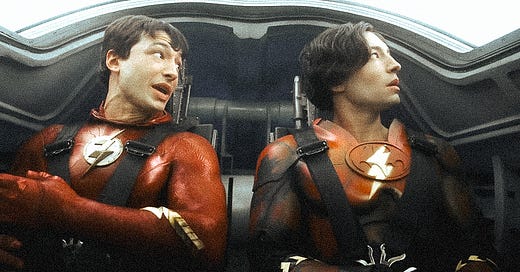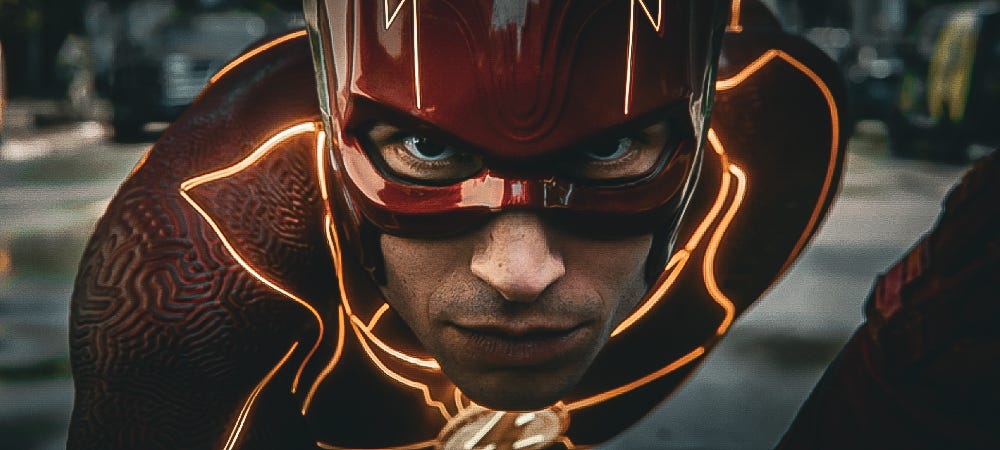Barry Allen and the league of very bad boys
Running thoughts on The Flash movie, the Ezra Miller question, and the 'art by bad artists' dilemma. Spoilers, because you’re probably not gonna see the film anyway.
I know a lot of people who refuse to see The Flash. Back in February, when I popped the new trailer into a group chat with some of my fellow nerds, observing that DC might actually ‘stick the landing on this one,’ the thread quickly turned to how the studio should have fired Ezra Miller long ago. (I mean, they took nearly a decade to make this movie, so something could have been done. Also, Grant Gustin is right there.) The consensus seemed to be that it was okay to see the film if, in the cinema’s foyer, we stood in a circle, held hands, and verbally acknowledged Miller’s crimes and allegations before taking our seats.
During that time, I considered writing another piece on the what do we do about art made by (morally) bad artists? question. People have been wrestling with this dilemma across numerous genres and industries. But, as a fan of the superhero genre, the Ezra Miller question felt more immediate. People around me were making decisions on whether to consume an as-yet-unreleased work of art whose public face is a man who1 got into numerous bar fights, has been accused of harassment, grooming, and manipulation, charged with burglary, and pled guilty to trespassing.2 All those public indiscretions may have played a part in the movie’s lackluster opening draw. All publicity is, alas, not good publicity.
I had previously taken a stab at the art by bad artists question in a piece hinged on the late (antisemitic) French writer Céline and his recently uncovered novels. But, in this case, the art and the artist face a reckoning before our eyes. It feels different.
As I watched The Flash this past weekend, I began to think a particular aspect of the movie could serve as a helpful cipher for the art by bad artists dilemma in general and the Ezra Miller question in particular. I’ll warn you: there isn’t much coherence here; I’m just playing in the sandbox. Also, I’m writing this faster than usual.
will the real Barry Allen please stand up
Going into the film, I expected a flaming succession of set pieces and overly climactic contests with various super-people delivering every inconsequential blow with earth-shattering intensity. I anticipated nothing more than a messy, fanboy-servicing spectacle. Instead, the film is surprisingly well-paced and not too intense by superhero smash-fest standards. It patiently weaves a story of a man so panged with long-term loss and grief over his mother's death and his father's imprisonment that he will break the world for the chance to bring them back.
Perhaps because the DCEU is falling apart, The Flash is free from the constraints of contributing to a larger narrative. It’s a good standalone film, pulling along the bare minimum threads of its precursors and doing next-to-nothing to set up any future for the cinematic universe. Its strongest suit is its protagonists, which include different versions of Batman and Supergirl from what we’ve seen on screen before. Unlike Justice League, it doesn’t feel overstuffed with personalities, each deserving their own acts. The four protagonists, once we meet all of them, complement each other nicely.
Of course, some Batman fans will be disappointed with Michael Keaton’s portrayal of Bruce Wayne starting out. He’s old, bearded, and long-haired. He paints and leaves the record playing long after he’s left the room, and his initial entrance is played for laughs. But this is a retired Bruce Wayne who has saved his city and hung up the batsuit without letting the darkness consume him. And, when Barry comes calling, he’s (eventually) willing to help.
And as for Supergirl: she’s the super-serious hero this movie needs. Played by Sasha Calle with knife’s edge intensity, Kara Zor-El isn’t what anyone expects, but she’s utterly immovable. And when Zod kills her, again and again, the loss is palpable.
As much as I love these depictions of Batman and Supergirl, The Flash does its best work in the pairing of Barry Allen with Barry Allen, a younger version of himself living in a timeline where his mother is still alive. (If you don’t know the bare threads of Barry’s story: his mother was murdered, and his father was found guilty of that crime and locked away. Years later, Barry became the Flash, gaining the ability to run so fast he could travel across time.)
The Barry Allen of the movie’s primary timeline is neurotic, perpetually tardy, and socially awkward. He quickly sees others as wrong and tends to do whatever he wants, mindless of the consequences. (He is still a member of the Justice League, however, and carries out his duties even if he complains about always having to clean up Batman’s messes.) He can be unlikable, and if you have qualms about Ezra Miller already, he’s probably not your favorite hero.
Then you meet Barry Allen #2, who is like our Barry but immature and kinda dumb. He has the opposite of gravitas and lacks more than a little common sense. We’re stuck with him though, because The Flash tosses out the well-worn time travel advice of never coming in contact with your past self. Our Barry and Barry #2 room together, train together, and go searching for Batman together.
And our Barry confronts Barry #2 on more than one occasion. He tells him he isn’t as funny or clever as he thinks. That he needs to take things seriously. That it isn’t all about him. In one sobering moment, our Barry observes, this is what people mean when they say I’m annoying.
That’s brilliant.
Ezra Miller: an elaborate prop?
So, what does that have to do with the Ezra Miller question—and our question of what we, the receivers of this art, ought to do with them?
Audiences that flock to superhero films instinctively associate the actor with the character they portray (assuming a successful portrayal). Robert Downey Jr. is Iron Man. Tobey Maguire and Tom Holland are Spider-Men. Scarlett Johansson is Black Widow. This sort of parasocial identification happens in other film and TV genres too, but much less often and with much less intensity. In a superhero film, the actor passes through a secondary identity to assume another primary identity. RDJ becomes Tony Stark so he can become Iron Man. The binding of man with mythic figure is that much more potent.
The intensity of this parasocial identification kind of proves that the art cannot be separated from the artist, right? At least in some cases. But a movie creates a dilemma because no single person (or small band of people) is fully responsible for the art. A painting, a book, an album are easy: there’s typically one artist associated with the art. We know their name. We know who to point fingers at.
But do we throw out Peter Jackson’s Lord of the Rings trilogy because Harvey Weinstein served as executive producer and it was his company’s money that started their production? Do we toss out The Flash because Ezra Miller is wearing the suit? Their role would be impossible without writers, directors, stunt guys, and VFX teams. Miller’s nothing more than an elaborate prop.
Still, as a culture, we identify Miller with/as “the Flash.” And their life taints the art or the perception of the art. But no art comes without such tainting, such dousing in life and humanity. No art comes without being dragged out of the depraved and aspirational human spirit.
art overcomes the artist
Art cannot escape the presence of the artist(s). That’s like asking for a body without a beating heart. The Flash cannot outrun Ezra Miller,3 despite their behavior breaking with the superhero ethos. It’s obvious that the costume doesn’t fit, and Miller’s presence in the film forces us to sit in a shadowland between a consistent heroic narrative and a realist one where the people we believe are heroes are often criminals.
Miller has publicly dichotomized—we all have in some way4—it’s just more apparent when there are two personas at odds with each other and we feel we must claim one and reject the other. It’s like being served a plate bearing something delicious and something spoiled. Of course, we’ll eat the delicious thing, but the other thing is still there, turning our stomachs. We choose the Flash persona and its accompanying good guy Barry Allen, but the Hydean shadow looms.
How do we deal with this? We don’t, because there is no we. Not in these sorts of questions. How we receive and participate in art, from any artist (not just the “complicated” ones), is an incredibly subjective experience—something Claire Dederer foot stomps in her book, Monsters: A Fan Dilemma:
Consuming a piece of art is two biographies meeting: the biography of the artist that might disrupt the viewing of the art; the biography of the audience member that might shape the viewing of the art. This occurs in every case.
Of course, we might all agree that a crime is a crime. But receiving art made by criminal hands? There’s the rub. That’s when the discrete indivdual must decide whether to receive the art and let his biography intersect with and be influenced by the biography of the artist.
William Empson, a literary critic and one of the forbears of New Criticism, said, “Life involves maintaining oneself between contradictions that can’t be solved by analysis.”
The Miller question can’t be solved by analysis, nor can it be solved by running away from one personality in favor of another. It can only be addressed by two selves brought together in confrontation, or in a sort of dance. Like the complicated artist and the equally complicated audience meeting on the terrain of the art.
Or like the Barrys in The Flash. In his younger, other self, our Barry truly sees who he is and who he can be.
I’ve said it before: art is a mirror of the artist, of the world, of the receiver of the art. In this way, the art overcomes the artist. The artist can see herself in her work because the work is at once within her and is greater than her. If Barry Allen is a good guy portrayed by a bad guy, hopefully that bad guy can see within himself, outside of himself, and within the aspirational ideation of the audience, his potential to be a good guy.
That’s all.
Jordan Moreau, “Ezra Miller’s Legal Troubles: A Timeline of Arrests and Controversies Before ‘The Flash’,” https://variety.com/2023/film/news/ezra-miller-arrests-allegations-timeline-flash-1235646961/
Is it worth pointing out that social media makes the you’re a bad person (or supporting a bad person) if you see this film argument seem a lot more extreme than it is? I’ve gotten pushback from some people, but nothing near the level of vehemence I’ve found online.
The luxury of the pre-information age is that people didn’t always know the artist and yet could enjoy the art.
I’ll talk about this more in a future post in the aesthetic series.






